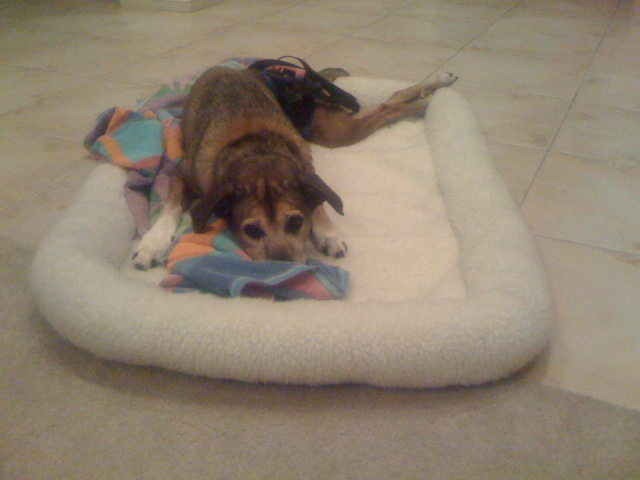
If you’re wondering what YouTube, a cozy bed and transportation have to do with the daily care of a paralyzed dog, they’re the third, fourth and fifth Lessons I learned from Sophie.
Here’s how they played out in our lives.
Lesson Three – Don’t underestimate the power of YouTube
I’m sure everyone today grasps the widespread knowledge of YouTube, but in 2008-2009 when Sophie started to lose the ability to walk, it was a different world.
As her condition got worse, my husband Ken and I realized we had two big hurdles to overcome. We needed a way to safely move Sophie around the house and outside and we had to learn how to express her bladder.
You see, unlike most dogs with diseases like IVDD (Intervertebral Disc Disease) and spinal injuries who happily scoot everywhere they want to go, Sophie was unable to move on her own.
I don’t know if it was because she was 10-years-old or if it was due to the nature of her illness. But she needed to be lifted in order to move.
Luckily it didn’t take long for YouTube to direct me to the perfect mobility harness from Walkabout Harnesses. It was also the start of a long-lasting relationship with the company and its founder, Cathy Erwin.
The Walkabout harness became my all-time favorite product for paralyzed dogs.
The harness fits like little pants over the hind quarters and stays in place with Velcro straps. It has two handles that made maneuvering Sophie’s mobility easy. I always had two on hand: one to wear and one as a backup.
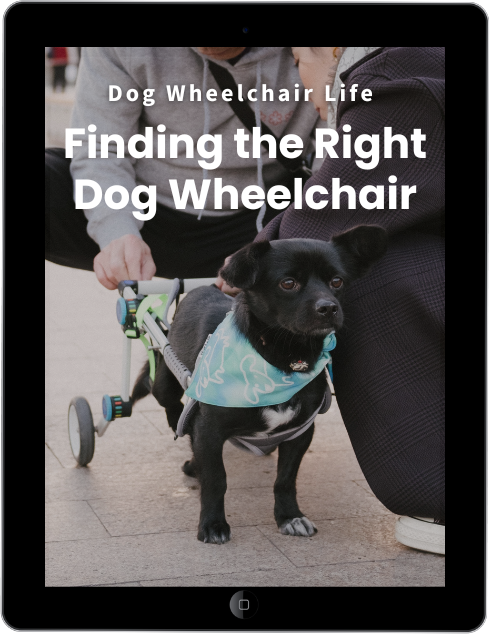
eBook
Find The Right Dog Wheelchair For Your Pet
Your dog has a mobility problem, and you want to buy a wheelchair. But do you know what kind of cart will work best for your dog’s individual needs? After a decade of teaching pet owners how to make the right choice, I put the information into an eBook!
Our second YouTube success
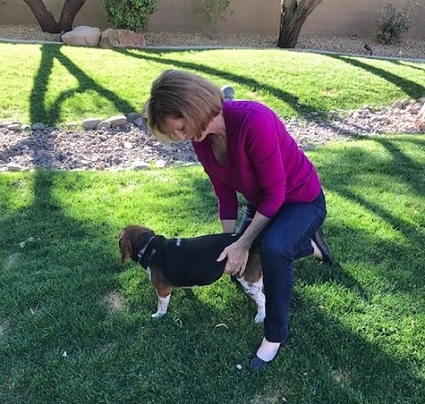
Overcoming our second obstacle of how to express Sophie’s bladder, made me fall in love with YouTube. Like most paralyzed dog’s she was incontinent and unable to pee without assistance.
We tried to use doggie diapers, but Sophie didn’t leak urine or involuntarily pee when her bladder was full. She needed to have it manually emptied.
Our vet explained the process and gave me a hands-on demonstration. But his technique had Sophie lying on her side instead of standing upright as she had done her whole life.
She hated the idea of lying on her side and fought me every time I tried to express her this way.
In frustration I asked YouTube for an answer. To my surprise a series of videos miraculously appeared on my computer screen.
I noticed that one video demonstrated a technique with the dog who was standing instead of lying down. The woman giving the tutorial had a female dog who was wearing the same harness we used.
She showed how to hold the dog with the harness in one hand while she slid her free arm under the dog’s belly. Then she pressed on the dog’s bladder.
The instructions were crystal clear and made sense for my situation.
I took Sophie to our lawn and followed the YouTube video instructions precisely. The technique worked just like the video said. Sophie wasn’t stressed and was happy to be standing like a normal dog once again.
We used this standing is technique, four times a day, for the next five years.
Lesson Four – A cozy bed has to be functional too
At first, I put Sophie in a thick, fluffy, expensive dog bed at night. It seemed like the right thing to do to make her comfortable. I soon learned it was the worst bed for her.
Poor Sophie had problems with her balance and sometime during the night she would fall off the tall bed.
So, I exchanged the thick mattress for a flat, orthopedic dog bed that had a bolster around the rim. It kept her body tucked safely in the base of the bed while letting her head rest on the bolster. The underside of the bed was sewn with a soft satin. That allowed me to easily pull the bed and Sophie, wherever we needed to go in the house.
Both Sophie and I loved the bed. It was inexpensive and completely machine washable. I kept one in the bedroom and one in the living room. And when it showed signs of much wear-and-tear, I would head to my local PetSmart for a new one.
This lesson taught me that function was more important than the cost of a cozy bed.
Lesson Five – It takes trial and error to find the best transportation
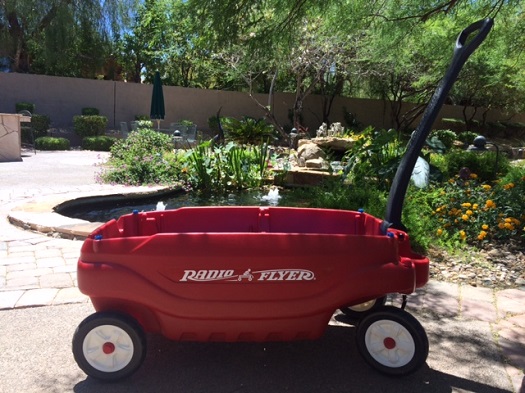
In 2009, dog wheelchairs weren’t as popular as they are today. I knew they existed, but getting one for Sophie wasn’t the first mobility device I chose.
Our first mode of transportation was a red Radio Flyer wagon. I liked the price point; it was easy to store and we could pull Sophie on a walk alongside our two other dogs. In theory it was the perfect solution.
The day we placed Sophie in her brand-new wagon, was the day I learned dogs could fly. During the 3 mile walk around our neighborhood, Sophie threw her body into the air and flipped out of the wagon.
My husband, our other dogs and I watched in horror as Sophie’s body crashed onto the sidewalk. We rushed over to access the damage.
Sophie was fine. She was angrier about being in a silly wagon, than she was hurt. She shook off the ordeal with a few flicks of her head and looked at us with determined eyes that said, “I dare you to put me back in that wagon.”
We never used the Radio Flyer wagon again. Many years later it became a favorite toy for my two granddaughters.
After the incident Ken and I went online to look at dog wheelchairs. And once again we thought we found the perfect solution.
Next came a dog wheelchair
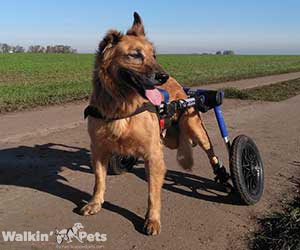
We decided the next purchase should be a dog wheelchair. I came across one made by Walkin’ Wheels by HandicappedPets.com. We measured Sophie, ordered the wheelchair and anxiously waited for it to arrive.
When it came, Ken and I noticed that it had a lot more parts than we expected, but we happily assembled it. Then we hoisted Sophie into her new set of wheels.
We held onto the cart as we walked her down our steep driveway. When we got to the sidewalk below, we let her go.
Sophie started to tremble. Ken and I did our best to reassure her, but she refused to move. Finally, we called it a day and went back inside.
We were disappointed about Sophie’s first lesson, but I’ve learned over the years that her reaction is pretty common. It can take time for a dog to build up their confidence to use a dog wheelchair.
We continued to practice and eventually Sophie learned to walk in her cart, but she never loved it the way we hoped.
And on several occasions, she tipped it over and would lie, flaying on her side. The experience would leave her so upset that we would have to carry her home.
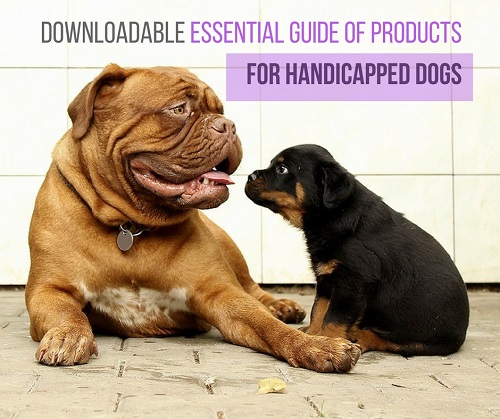
Get the Essential Guide
The Essential Guide of Products for Handicapped Dogs e-book is a labor of love for me. I wrote it to answer your most pressing questions about where to find the best products for your wheelchair dog. You’ll find products you didn’t know existed and each will improve your dog’s quality of life. Print a copy and keep it by your side.
Moving to a third form of transportation
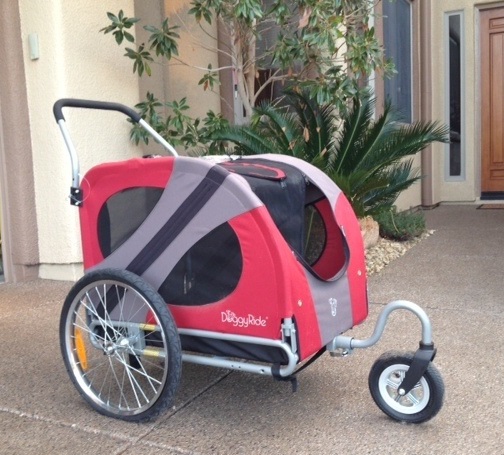
I started to study dogs that walked around our neighborhood for ideas. One that stood out was a doggie stroller. The dogs I saw looked happy riding around in them. The problem was that strollers seemed to be for small dogs and Sophie relatively large.
Then one day, while I was volunteering at a community event for homeless pets, I saw a large elderly dog being pushed in a fully enclosed cart.
His owner told me the cart was built to be towed behind a bike, but she had added handlebars and a front wheel. She also told me about a ready-made cart like hers, on the Internet. She recommended I look at a company called Doggyride.
When I went to their website, I saw a whole line of beautiful and comfortable dog strollers for medium to large breed dogs. I ordered one on the spot.
Finally, we had stumbled onto the “actual” perfect solution. Sophie loved this cart. She was able to sit comfortably, like a princess, inside an enclosed compartment where she was secure and unable to fall out.
Her Doggyride had a mesh screen on all sides that allowed all of the wonderful outdoor scents to come inside. She was able to see through the mesh windows and she strolled alongside our two other dogs throughout the entire walk.
Sophie used this cart every single day. It was a great victory in helping her feel normal again.
Click here to continue reading the next set of Lessons.


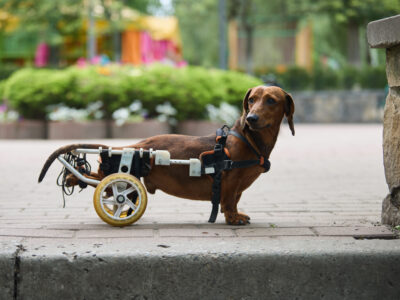
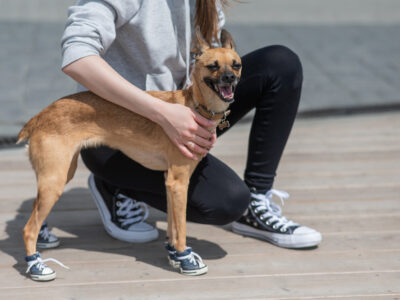

Leave a Reply